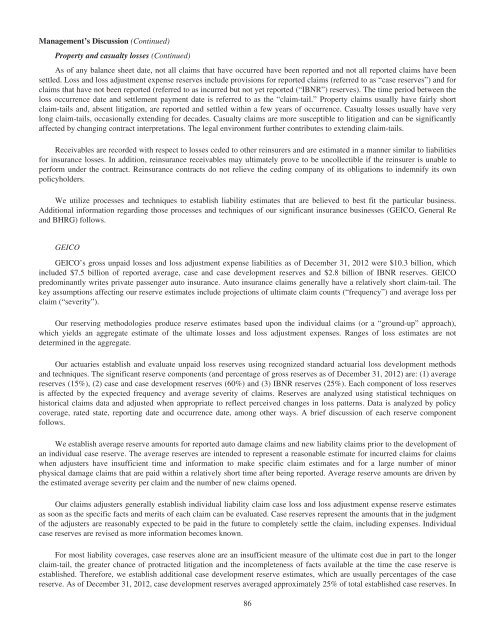BERKSHIRE HATHAWAY
BERKSHIRE HATHAWAY
BERKSHIRE HATHAWAY
Create successful ePaper yourself
Turn your PDF publications into a flip-book with our unique Google optimized e-Paper software.
Management’s Discussion (Continued)<br />
Property and casualty losses (Continued)<br />
As of any balance sheet date, not all claims that have occurred have been reported and not all reported claims have been<br />
settled. Loss and loss adjustment expense reserves include provisions for reported claims (referred to as “case reserves”) and for<br />
claims that have not been reported (referred to as incurred but not yet reported (“IBNR”) reserves). The time period between the<br />
loss occurrence date and settlement payment date is referred to as the “claim-tail.” Property claims usually have fairly short<br />
claim-tails and, absent litigation, are reported and settled within a few years of occurrence. Casualty losses usually have very<br />
long claim-tails, occasionally extending for decades. Casualty claims are more susceptible to litigation and can be significantly<br />
affected by changing contract interpretations. The legal environment further contributes to extending claim-tails.<br />
Receivables are recorded with respect to losses ceded to other reinsurers and are estimated in a manner similar to liabilities<br />
for insurance losses. In addition, reinsurance receivables may ultimately prove to be uncollectible if the reinsurer is unable to<br />
perform under the contract. Reinsurance contracts do not relieve the ceding company of its obligations to indemnify its own<br />
policyholders.<br />
We utilize processes and techniques to establish liability estimates that are believed to best fit the particular business.<br />
Additional information regarding those processes and techniques of our significant insurance businesses (GEICO, General Re<br />
and BHRG) follows.<br />
GEICO<br />
GEICO’s gross unpaid losses and loss adjustment expense liabilities as of December 31, 2012 were $10.3 billion, which<br />
included $7.5 billion of reported average, case and case development reserves and $2.8 billion of IBNR reserves. GEICO<br />
predominantly writes private passenger auto insurance. Auto insurance claims generally have a relatively short claim-tail. The<br />
key assumptions affecting our reserve estimates include projections of ultimate claim counts (“frequency”) and average loss per<br />
claim (“severity”).<br />
Our reserving methodologies produce reserve estimates based upon the individual claims (or a “ground-up” approach),<br />
which yields an aggregate estimate of the ultimate losses and loss adjustment expenses. Ranges of loss estimates are not<br />
determined in the aggregate.<br />
Our actuaries establish and evaluate unpaid loss reserves using recognized standard actuarial loss development methods<br />
and techniques. The significant reserve components (and percentage of gross reserves as of December 31, 2012) are: (1) average<br />
reserves (15%), (2) case and case development reserves (60%) and (3) IBNR reserves (25%). Each component of loss reserves<br />
is affected by the expected frequency and average severity of claims. Reserves are analyzed using statistical techniques on<br />
historical claims data and adjusted when appropriate to reflect perceived changes in loss patterns. Data is analyzed by policy<br />
coverage, rated state, reporting date and occurrence date, among other ways. A brief discussion of each reserve component<br />
follows.<br />
We establish average reserve amounts for reported auto damage claims and new liability claims prior to the development of<br />
an individual case reserve. The average reserves are intended to represent a reasonable estimate for incurred claims for claims<br />
when adjusters have insufficient time and information to make specific claim estimates and for a large number of minor<br />
physical damage claims that are paid within a relatively short time after being reported. Average reserve amounts are driven by<br />
the estimated average severity per claim and the number of new claims opened.<br />
Our claims adjusters generally establish individual liability claim case loss and loss adjustment expense reserve estimates<br />
as soon as the specific facts and merits of each claim can be evaluated. Case reserves represent the amounts that in the judgment<br />
of the adjusters are reasonably expected to be paid in the future to completely settle the claim, including expenses. Individual<br />
case reserves are revised as more information becomes known.<br />
For most liability coverages, case reserves alone are an insufficient measure of the ultimate cost due in part to the longer<br />
claim-tail, the greater chance of protracted litigation and the incompleteness of facts available at the time the case reserve is<br />
established. Therefore, we establish additional case development reserve estimates, which are usually percentages of the case<br />
reserve. As of December 31, 2012, case development reserves averaged approximately 25% of total established case reserves. In<br />
86


